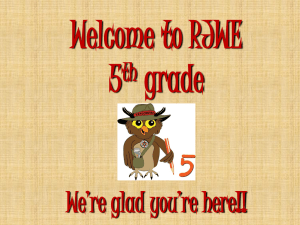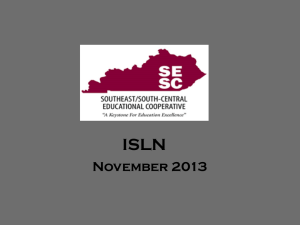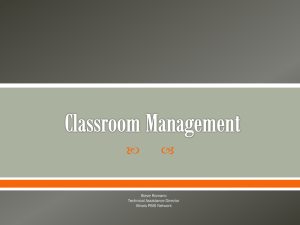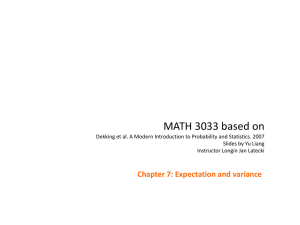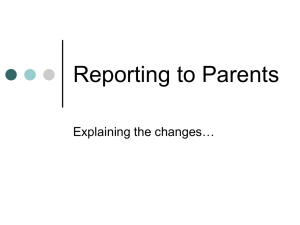HB1490 K-5 Proposed Science Standards
advertisement
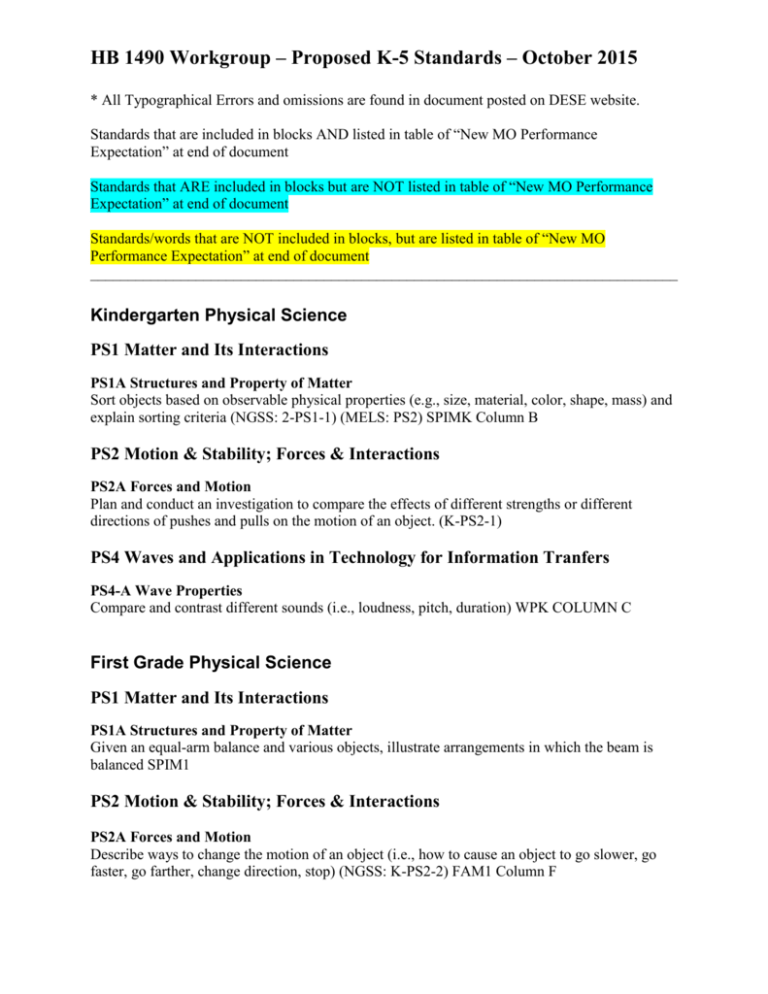
HB 1490 Workgroup – Proposed K-5 Standards – October 2015 * All Typographical Errors and omissions are found in document posted on DESE website. Standards that are included in blocks AND listed in table of “New MO Performance Expectation” at end of document Standards that ARE included in blocks but are NOT listed in table of “New MO Performance Expectation” at end of document Standards/words that are NOT included in blocks, but are listed in table of “New MO Performance Expectation” at end of document ______________________________________________________________________________ Kindergarten Physical Science PS1 Matter and Its Interactions PS1A Structures and Property of Matter Sort objects based on observable physical properties (e.g., size, material, color, shape, mass) and explain sorting criteria (NGSS: 2-PS1-1) (MELS: PS2) SPIMK Column B PS2 Motion & Stability; Forces & Interactions PS2A Forces and Motion Plan and conduct an investigation to compare the effects of different strengths or different directions of pushes and pulls on the motion of an object. (K-PS2-1) PS4 Waves and Applications in Technology for Information Tranfers PS4-A Wave Properties Compare and contrast different sounds (i.e., loudness, pitch, duration) WPK COLUMN C First Grade Physical Science PS1 Matter and Its Interactions PS1A Structures and Property of Matter Given an equal-arm balance and various objects, illustrate arrangements in which the beam is balanced SPIM1 PS2 Motion & Stability; Forces & Interactions PS2A Forces and Motion Describe ways to change the motion of an object (i.e., how to cause an object to go slower, go faster, go farther, change direction, stop) (NGSS: K-PS2-2) FAM1 Column F HB 1490 Workgroup – Proposed K-5 Standards – October 2015 * All Typographical Errors and omissions are found in document posted on DESE website. Standards that are included in blocks AND listed in table of “New MO Performance Expectation” at end of document Standards that ARE included in blocks but are NOT listed in table of “New MO Performance Expectation” at end of document Standards/words that are NOT included in blocks, but are listed in table of “New MO Performance Expectation” at end of document ______________________________________________________________________________ PS4 Waves and Applications in Technology for Information Tranfers PS4-A Wave Properties Compare and contrast different sounds (i.e., loudness, pitch, duration) WPK COLUMN C PS4B Electromagnetic Radiation Identify the source of energy that causes an increase in the temperature of an object (e.g., Sun, stove, flame, light bulb) SPIM1 Column E PS4C Information Technologies and Instrumentation 1-PS4-4. Use tools and materials to design and build a device that uses light or sound to solve the problem of communicating over a distance* Second Grade Physical Science PS1 Matter and Its Interactions PS1-A Structure and Properties of Matter "Plan and conduct an investigation to describe and classify different kinds of materials by their observable properties. (2-PS1-1)" Analyze data obtained from testing different materials to determine which materials have the properties that are best suited for an intended purposes. (2-PS1-2)* PS1-B Types of Interactions of Matter Describe ways to separate the components of a mixture by their physical properties (e.g., sorting, magnets, screening) SPIM2 Column E PS2 Motion & Stability; Forces & Interactions PS2-A Forces and Motions Predict and demonstrate how the motion of an object could be changed by an applied force or the mass of an object FAM2 COLUMN H HB 1490 Workgroup – Proposed K-5 Standards – October 2015 * All Typographical Errors and omissions are found in document posted on DESE website. Standards that are included in blocks AND listed in table of “New MO Performance Expectation” at end of document Standards that ARE included in blocks but are NOT listed in table of “New MO Performance Expectation” at end of document Standards/words that are NOT included in blocks, but are listed in table of “New MO Performance Expectation” at end of document ______________________________________________________________________________ PS4 Waves and Applications in Technology for Information Tranfers PS4-A Wave Properties Plan and conduct investigations to provide evidence that changes in vibration create change in sound WP2 Third Grade Physical Science PS1 Matter and Its Interactions PS1A Structure and Properties of Matter Predict and investigate that water can change from a liquid to a solid (freeze), and back again (melt), or from a liquid to a gas (evaporation), and back again (condensation) as the result of temperature changes SPM3 Column F PS1B Types of Interactions of Matter Construct an argument with evidence that some changes caused by heating or cooling can be reversed and some cannot (2-PS1-4) PS2 Motion & Stability; Forces & Interactions PS2B Types of Interactions Predict and describe the electric or magnetic interactions between two objects not in contact with each other. (3-PS2-3) Predict the effects of an electrostatic force (static electricity) on the motion of objects (attract or repel) 3-PS2-3 FAM4 Column F Fourth Grade Physical Science PS1 Matter and Its Interactions PS1B Types of Interactions of Matter Describe ways to separate the components of a mixture/solution by their physical properties (i.e., HB 1490 Workgroup – Proposed K-5 Standards – October 2015 * All Typographical Errors and omissions are found in document posted on DESE website. Standards that are included in blocks AND listed in table of “New MO Performance Expectation” at end of document Standards that ARE included in blocks but are NOT listed in table of “New MO Performance Expectation” at end of document Standards/words that are NOT included in blocks, but are listed in table of “New MO Performance Expectation” at end of document ______________________________________________________________________________ sorting, filtration, magnets, screening) SPIM4 COLUMN I PS2 Motion & Stability; Forces & Interactions PS2A Forces and Motion Make observations and/or measurements of an object’s motion to provide evidence that a pattern can be used to predict future motion. (3-PS2-2) Plan and conduct an investigation to provide evidence of the effects of balanced and unbalanced forces on the motion of an object. (3-PS2-1) PS2B Types of Interactions Plan and conduct a fair test to compare and contrast the forces (measured by a spring scale in newtons) required to overcome friction when an object moves over different surfaces (i.e., rough/smooth) FAM4 Predict how changes in either the amount of force applied to an object or the mass of the object affects the motion (speed and direction) of the object 3-PS2-2 FAM4 Column L PS3 Energy PS3A Defintions of Energy Use evidence to construct an explanation relating the speed of an object to the energy of that object. (4-PS3-1) PS3B Conservation of Energy and Energy Transfer Make observations to provide evidence that energy can be TRANSFERRED from place to place by sound, light, heat, and electric currents. (4-PS3-2) Provide evidence to construct an explanation of an energy TRANSFORMATION (e.g. temperature change, light, sound, motion, and magnetic effects). 4-PS3-2n CEET4 COLUMN E Apply scientific ideas to design, test, and refine a device that converts energy from one form to another. (4-PS3-4)* HB 1490 Workgroup – Proposed K-5 Standards – October 2015 * All Typographical Errors and omissions are found in document posted on DESE website. Standards that are included in blocks AND listed in table of “New MO Performance Expectation” at end of document Standards that ARE included in blocks but are NOT listed in table of “New MO Performance Expectation” at end of document Standards/words that are NOT included in blocks, but are listed in table of “New MO Performance Expectation” at end of document ______________________________________________________________________________ PS4 Waves and Applications in Technology for Information Tranfers PS4A Wave Properties Develop a model of waves to describe patterns in terms of amplitude or wavelength and that waves can cause objects to move. (Boundary: The terms amplitude and wavelength should not be assessed.) (4-PS4-1) Fifth Grade Physical Science PS1 Matter and Its Interactions PS1-A Structure and Properties of Matter Develop a model to describe that matter is made of particles too small to be seen. (5-PS1-1) Measure and graph quantities to provide evidence that regardless of the type of change that occurs when heating, cooling, or mixing substances, the total weight of matter is conserved. (5PS1-2) PS1-B Types of Interactions of Matter Conduct an investigation to determine whether the combining of two or more substances results in new substances. (5-PS1-4) PS2 Motion & Stability; Forces & Interactions PS2-B Types of Interactions Support an argument that the gravitational force exerted by Earth on objects is directed toward the planet's center (5-PS2-1) PS3 Energy PS3-B Conservation of Energy and Energy Transfer Observe and explain how an object (e.g., moon, mirror, objects in a room) can only be seen when light is reflected from that object to the receiver (eye) 4-PS4-2 CEET5 COLUMN C HB 1490 Workgroup – Proposed K-5 Standards – October 2015 * All Typographical Errors and omissions are found in document posted on DESE website. Standards that are included in blocks AND listed in table of “New MO Performance Expectation” at end of document Standards that ARE included in blocks but are NOT listed in table of “New MO Performance Expectation” at end of document Standards/words that are NOT included in blocks, but are listed in table of “New MO Performance Expectation” at end of document ______________________________________________________________________________ PS3-C Relationship between Energy and Forces Observe and explain that simple machines change the amount of effort force and/or direction of force FAM5 PS3-D Energy in Chemical Processes and Every Day Life Use models to describe that energy stored in food (used for body repair, growth, motion, and to maintain body warmth) was once energy from the sun. (5-PS3-1) PS4 Waves and Applications in Technology for Information Tranfers PS4-B Electromagnetic Radiation Develop a model to describe that objects can be seen only when light is reflected off them or when they produce their own light. (NGSS: 1-PS4-2) L3 COLUMN C HB 1490 Workgroup – Proposed K-5 Standards – October 2015 * All Typographical Errors and omissions are found in document posted on DESE website. Standards that are included in blocks AND listed in table of “New MO Performance Expectation” at end of document Standards that ARE included in blocks but are NOT listed in table of “New MO Performance Expectation” at end of document Standards/words that are NOT included in blocks, but are listed in table of “New MO Performance Expectation” at end of document ______________________________________________________________________________ Kindergarten Life Science LS1 From Molecules to Organisms: Structures and Process LS1A Structure and Function Use materials to design a solution to a human problem by mimicking how plants and/or animals use their external parts to help them survive, grow, and meet their needs. 1-LS1D LS3 Heredity and Inheritance: Variation of Traits LS3A Inheritance of Traits Make observations to construct an evidence based account that young plants and animals are like, but not exactly like, their parents. 1-LS3B (NGSS: 1-LS3-1) LS1C Organization for Matter and Energy Flow in Organisms STRAND 3 Use observations to describe patterns of what plants and animals (including humans) need to survive. (NGSS: K-LS1-1) First Grade Life Science LS1 From Molecules to Organisms: Structures and Process LS1A Structure and Function Use materials to design a solution to a human problem by mimicking how plants and/or animals use their external parts to help them survive, grow, and meet their needs. 1-LS1D LS3 Heredity and Inheritance: Variation of Traits LS3A Inheritance of Traits Make observations to construct an evidence based account that young plants and animals are like, but not exactly like, their parents. 1-LS3B (NGSS: 1-LS3-1) HB 1490 Workgroup – Proposed K-5 Standards – October 2015 * All Typographical Errors and omissions are found in document posted on DESE website. Standards that are included in blocks AND listed in table of “New MO Performance Expectation” at end of document Standards that ARE included in blocks but are NOT listed in table of “New MO Performance Expectation” at end of document Standards/words that are NOT included in blocks, but are listed in table of “New MO Performance Expectation” at end of document ______________________________________________________________________________ Second Grade Life Science LS1 From Molecules to Organisms: Structures and Process LS1-A Structure and Function Identify and compare the physical structures of a variety of animals (e.g., sensory organs, beaks, appendages, body covering) (Do NOT assess terms: sensory organs, appendages) (NGSS: 1LS1-1*) LS2: Ecosystems: Interactions, Energy, and Dynamics LS2-A Interdependant Relationships in Ecosystems Predict and investigate the growth of plants when growing conditions are altered (e.g., dark vs. light, water vs. no water) (NGSS 2-LS2-1) Develop a simple model that mimics the function of an animal in dispersing seeds or pollinating plants. (NGSS 2-LS2-2) Third Grade Life Science LS1 From Molecules to Organisms: Structures and Process LS1B Growth and Development of Organism Develop a model to compare and contrast observations on the life cycle of different animals. (NGSS: 3-LS1-1) LS3 Heredity and Inheritance: Variation of Traits LS3A Inheritance of Traits Construct scientific arguments to support claims that some characteristics of organisms are inherent from parents and some are influenced by the environment. HB 1490 Workgroup – Proposed K-5 Standards – October 2015 * All Typographical Errors and omissions are found in document posted on DESE website. Standards that are included in blocks AND listed in table of “New MO Performance Expectation” at end of document Standards that ARE included in blocks but are NOT listed in table of “New MO Performance Expectation” at end of document Standards/words that are NOT included in blocks, but are listed in table of “New MO Performance Expectation” at end of document ______________________________________________________________________________ LS4 Biological Evolution: Unity and Diversity LS4B Natural Selection Use evidence to construct an explanation for how the variations in characteristics among individuals of the same species may provide advantages in surviving and finding mates. (NGSS: 3-LS4-2) LS4C Adaption Construct an argument with evidence that in a particular ecosystem some organisms -- based on structural adaptations or behaviors -- can survive well, some survive less well, and some cannot survive at all. (NGSS: 3-LS4-2) LS4D Biodiverity and Humans Make a claim about the merit of a solution to a problem caused when the environment changes and the types of plants and animals that live there may change. Fourth Grade Life Science LS1 From Molecules to Organisms: Structures and Process LS1A Structure and Function Construct an argument that plants and animals have internal and external sturctures that function to support survival, growth, behavior, and plant reproduction. (4-LS1 -1) LS1D Information Processing Use a model to describe that animals receive different types of information through their senses, process the information in their brain, and respond to the information in different ways. (4-LS1 2) Fifth Grade Life Science LS1 From Molecules to Organisms: Structures and Process HB 1490 Workgroup – Proposed K-5 Standards – October 2015 * All Typographical Errors and omissions are found in document posted on DESE website. Standards that are included in blocks AND listed in table of “New MO Performance Expectation” at end of document Standards that ARE included in blocks but are NOT listed in table of “New MO Performance Expectation” at end of document Standards/words that are NOT included in blocks, but are listed in table of “New MO Performance Expectation” at end of document ______________________________________________________________________________ LS1-A Structure and Function Compare and contrast the major organs/organ systems (e.g. support, reproductive, digestive, transport/circulatory, excretory, response) that perform similar functions for animals belonging to different vertebrate classes Compare and contrast structures (e.g., wings vs. fins vs. legs; gills vs. lungs; feathers vs. hair vs. scales) that serve similar functions for animals belonging to different vertebrate classes LS1-C Organization for Matter and Energy Flow in Organisms Support an argument that plants get the materials (i.e. carbon dioxide, water, sunlight) they need for growth chiefly from air and water (5-LS1-1) LS2: Ecosystems: Interactions, Energy, and Dynamics LS2-A Interdependent Relationships in Ecosystems Predict the possible effects on a food chain or food web of adding or removing an organism LS2-B Cycles of Matter and Energy Transfers in Ecosystems Develop a model to describe the movement of matter among plants, animals, decomposers, and the environment (NGSS: 5-LS2-1) HB 1490 Workgroup – Proposed K-5 Standards – October 2015 * All Typographical Errors and omissions are found in document posted on DESE website. Standards that are included in blocks AND listed in table of “New MO Performance Expectation” at end of document Standards that ARE included in blocks but are NOT listed in table of “New MO Performance Expectation” at end of document Standards/words that are NOT included in blocks, but are listed in table of “New MO Performance Expectation” at end of document ______________________________________________________________________________ Kindergarten Earth Science ESS1 Earth's Place in the Universe ESS1A The Universe and Its Stars Describe the presence of the Sun, Moon, and stars in the sky over time (NGSS: K-ESS1-1) KColumn B ESS2 Earth’s Systems ESS2D Weather and Climate Use and share observations of local weather conditions to describe patterns over time. K-ESS2-1 ESS2E Biology With prompting and support, construct an argument using evidence for how plants and animals (including but not limited to humans) can change the environment to meet their needs. K-ESS2-2 ESS3 Earth and Human Activity ESS3A Natural Resources Use a model to represent the relationship between the needs of different plants or animals (including humans) and the places they live. K-ESS3-1 ESS3C Human Impacts on Earth Systems Communicate solutions that will reduce the impact of humans on the land, water, air, and/or other living things in the local environment. *K-ESS3-3 First Grade Earth Science ESS1 Earth's Place in the Universe ESS1A The Universe and Its Stars Use observations of the sun, moon, and stars to describe patterns that can be predicted. 1-ESS1-1 HB 1490 Workgroup – Proposed K-5 Standards – October 2015 * All Typographical Errors and omissions are found in document posted on DESE website. Standards that are included in blocks AND listed in table of “New MO Performance Expectation” at end of document Standards that ARE included in blocks but are NOT listed in table of “New MO Performance Expectation” at end of document Standards/words that are NOT included in blocks, but are listed in table of “New MO Performance Expectation” at end of document ______________________________________________________________________________ ESS2 Earth’s Systems ESS2D Weather and Climate Make observations during different seasons to relate the amount of daylight to the time of year. 1-ESS1-2 Identify patterns indicating relationships between observed weather data and weather phenomena (e.g., temperature and types of precipitation, clouds and amounts of precipitation) WC1 Column E Second Grade Earth Science ESS1 Earth's Place in the Universe ESS1-C The History of the Planet Use information from several sources to provide evidence that Earth events can occur quickly or slowly. 2-ESS1-1 ESS2 Earth’s Systems ESS2-A Earth's Materials and Systems Compare multiple solutions designed to slow or prevent wind or water from changing the shape of the land. *2-ESS2-1 ESS2-B Plate Tectonics and Large Scale Systems Interactions Develop a model to represent the shapes and kinds of land and bodies of water in an area. 2ESS2-2 ESS2-C Roles of Water in Earths Surface Processes Obtain information to identify where water is found on Earth and that it can be solid or liquid. 2ESS2-3 HB 1490 Workgroup – Proposed K-5 Standards – October 2015 * All Typographical Errors and omissions are found in document posted on DESE website. Standards that are included in blocks AND listed in table of “New MO Performance Expectation” at end of document Standards that ARE included in blocks but are NOT listed in table of “New MO Performance Expectation” at end of document Standards/words that are NOT included in blocks, but are listed in table of “New MO Performance Expectation” at end of document ______________________________________________________________________________ Third Grade Earth Science ESS1 Earth's Place in the Universe ESS1B Earth and the Solar System Explain how the Sun's position in the sky and the Earth's rotation affect the length and direction of shadows. (NGSS: 5-ESS1-2*) ESS3 Column I ESS2D Weather and Climate Represent data in tables and graphical displays to describe typical weather conditions expected during a particular season. 3-ESS2-1 Obtain and combine information to describe climates in different regions of the world. 3-ESS2-2 ESS3 Earth and Human Activity ESS3B Natural Hazards Make a claim about the merit of an existing design solution (e.g. levies, tornado shelters, sea walls, etc) that reduces the impacts of a weather-related hazard. *3-ESS3-1 Fourth Grade Earth Science ESS1 Earth's Place in the Universe ESS1C The History of the Planet Identify evidence from patterns in rock formations and fossils in rock layers to support an explanation for changes in a landscape over time. 4-ESS1-1 ESS2 Earth’s Systems ESS2A Earth Materials and Systems Plan and conduct scientific investigations or simulations to determine how natural processes (e.g. weathering and erosion) shape Earth's surfaces CMETE 4.2 Column I ESS2B Plate Tectonics and Large Scale Systems Interactions HB 1490 Workgroup – Proposed K-5 Standards – October 2015 * All Typographical Errors and omissions are found in document posted on DESE website. Standards that are included in blocks AND listed in table of “New MO Performance Expectation” at end of document Standards that ARE included in blocks but are NOT listed in table of “New MO Performance Expectation” at end of document Standards/words that are NOT included in blocks, but are listed in table of “New MO Performance Expectation” at end of document ______________________________________________________________________________ Analyze and interpret data from maps to describe patterns of Earth’s features. 4-ESS2-2 ESS3 Earth and Human Activity ESS3B Natural Hazards Generate and compare multiple solutions to reduce the impacts of natural Earth processes on humans. *4-ESS3- Fifth Grade Earth Science ESS1 Earth's Place in the Universe ESS1A The Universe and Its Stars Support an argument that relative distances from Earth affects the apparent brightness of the sun compared to other stars. 5-ESS1-1. ESS1B Earth and the Solar System Represent data in graphical displays to reveal patterns of daily changes in length and direction of shadows, day and night, and the seasonal appearance of some stars in the night sky. 5-ESS1-2 ESS2 Earth’s Systems ESS2A Earth Materials and Systems Develop a model using an example to describe ways the geosphere, biosphere, hydrosphere, and/or atmosphere interact. 5-ESS2-1 ESS2-C Roles of Water in Earths Surface Processes Describe and graph the amounts and percentages of water and fresh water in various reservoirs to provide evidence about the distribution of water on Earth. ESS3 Earth and Human Activity ESS3C Human Impacts on Earth Systems Obtain and combine information about ways individual communities use science ideas to protect the Earth’s resources and environment. 5-ESS3-1
